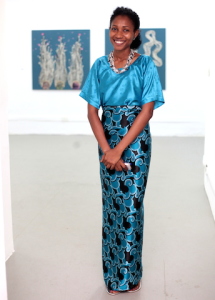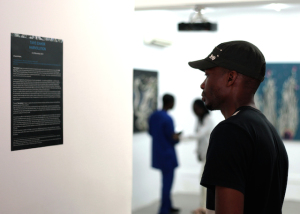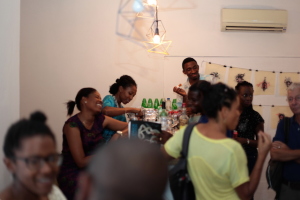[VOA] - The young Nigerian sculptor scanned the gallery with satisfaction. Drinks and snacks were laid out neatly on a corner table while her works of sculpture lit up the white walls of the gallery like art on a canvas. Her solo exhibition was about to open and she expected guests from all over Lagos.
Taiye Idahor had mounted her three-week exhibition at WhiteSpace in Ikoyi Lagos Nigeria to display her own exploration of the themes of reincarnation, culture and identity. She used her hair as a navigator to find her roots and her voice, and to bring back memories. So, she called the show Hairvolution.
“I got it from the word evolution, to evolve,” the artist said. “The idea of hair being my point of departure from the beginning of the project.”
But the project really isn’t about hair.
“It led me into thinking about memory,” she says, “and how we -- as people -- should value the memories that we have and we make, especially our parents. Because this project was also based on the memory of my dad and my mum,” said Taiye.
Her own hair is long and wavy, unlike the usual short and kinky-haired Nigerians are known for. So she drew from her personal experience of being continually asked about the origin of her hair. Taiye explored her family history and the possibility that she was a reincarnation of her paternal grandmother, Ayie, who is said to be a Caucasian.
Discovering the fragility of memory
Taiye never met Ayie. She questioned her parents for clues and answers to help her form what has now become her first solo exhibition- a collection of self-portraits on tracing papers titled Shut Cut, a photo-collage tagged Odowa, a sculpture of a face with exaggerated long hair made from newsprint. “Somehow, it is a material that has been consistent in my work since 2010 when I started working professionally,” says the artist. She plans to continue using the material.
By showing faces with long hair in repetitive form, Taiye expressed her identity intertwined with that of her grandmother. She grew up hearing her father say she is Ayie reincarnate.
In the course of building on the year-long project, Taiye was confronted with the fragility of memory itself. She also sees the disappearing cultures of Africa as people embrace modernity in all its form.
Dressed in silky Iro and Buba -- a traditional outfit popular among Yoruba women -- the young artist’s slim figure moves hurriedly around the gallery. Her fragile look contradicts the strength of conviction it took for her to pull off this exhibition.
The viewer who is struck by her strength of purpose is tempted to ask if the fragility of the newsprint reminds her of her own body -- fragile yet able to produce a quality of strength.
Young artists of Lagos
Taiye [is from Benin], a city in Edo state in southern Nigeria, but she grew up in Lagos, Nigeria’s commercial hub and a thriving center of creativity. She graduated from Yaba College of Technology, a Lagos polytechnic, in 2007. When she began her career in art, she found a small, young and vibrant community of supporters.
“We also have a lot of young people who are beginning to collect arts which is good and encouraging,” she said. “Because most of the older collectors are very strict on the kind of work they collect because they’ve been exposed to mostly paintings and sculpture.”
As Taiye talks, one of the first guests to enter the gallery is the Lagos painter, Kelani Abass. He is very impressed and as he examines her work he tells her the work is very strong in terms of “medium and materials, and again the theme of the artist.”
Abass is familiar with the other young Lagos artists experimenting with materials and ideas. He thinks Taiye’s Hairvolution is unique. “I like what I’m seeing.”
But many Nigerians still find it difficult to embrace the arts. Even a young photographer, Bola Oguntade, says so. “I have a funny opinion about art. Sometimes I find it difficult seeing that thing people really stare at … I just try to wonder what is this thing that they are in awe of.”
But he looks at the walls of Taiye’s exhibition and says, “When you look at what she has done… you can appreciate it for aesthetics. You can appreciate it for the message.”
Looking for support
Young artists struggle to find audience in a city where permanent galleries are few. Taiye says, “We don’t have enough standard galleries who are able to work with artists and represent artists. Art is not something that people collect all the time- it has its season.” When the season ends, buyers are few and young artists facing lack of sales are tempted by other work that pays the bills.
“We need more institutions,” Taiye says, “more galleries, proper galleries who represent artists -- because for now all we do is go from gallery to gallery,” says Taiye.
If Taiye had a gallery to represent her work regularly, she could more easily curate shows, find sponsors and look for other exhibition space and the refreshments for shows like this one. “Even up to the refreshment, I paid for it myself so it is a lot of responsibility on the young person.”
Some of the city’s young artists are joining a collective created by visual and performance artist Wura Ogunji, who wants to gather young talent who will support one another with constructive criticism.
“You look at a person walking down the street here and they are totally pushing boundaries and experimenting,” said Ogunji. However, you also see established artists whose work stifles creativity “which is ironic because artists are the ones that should be experimenting and pushing boundaries and risk-taking.
“I think that the most important thing is to continue to make work and to trust your own vision and not worry about anyone,” she said.
Whitespace is a private venture that survives on a percentage of the sales of the works of the artists they recruit to show there. The gallery offers what one of the coordinators Malaika Toyo calls “concept space,” a blank canvas for the artist and the buyer.
“We look for young people that are talented people that have been undiscovered and we give them visibility,” Toyo said. “Art is something that never dies,” she said. “The more you do it, the better you get at it.”
Saving African memory in art
 Taiye’s first day of the exhibition was a success. An environmentalist and enthusiast for the arts, Kofo Adeleke, was struck by what she saw. “I am so pleased that I got here now and everything is sold out. I think that is absolutely fantastic. The fact that all of her work got sold out so quickly shows you the kind of impact she has had.”
Taiye’s first day of the exhibition was a success. An environmentalist and enthusiast for the arts, Kofo Adeleke, was struck by what she saw. “I am so pleased that I got here now and everything is sold out. I think that is absolutely fantastic. The fact that all of her work got sold out so quickly shows you the kind of impact she has had.”
Taiye did experience impressive sales, however she pointed out that not everything sold. But Adeleke is optimistic about Taiye’s future. She said Taiye’s work is going to appeal to a larger market.
“I think this is going to have a much wider audience in Nigeria and outside Nigeria. I think what she is starting to do is very, very interesting and I love her honesty and I love her bravery.”
“The work is about her hair,” said Ogunji, “but it is also about her relationship with her family and her grandmother. It is not so explicit but it is also embedded in the conversation about herself. What she represents. Then she uses her own face in repetition. Then her face becomes her hair. And also a language of this drawing that she is making.”
Despite the flattery of the crowd at the gallery that day, the artist continues to focus on her core message of memory and culture. That the African continent save and pass on its culture as the young generation becomes increasingly mobile and breaks with the older generation who hold the undocumented history in their memories.
“Everything I used to make this body of work is based on things my parents told me based on their memories, the experiences they had and things they heard,” Taiye says.
“Art is my own way of recording a memory, fixing or lets say reviving a memory that otherwise could die with them when they age and pass away.”
Photo credit: Bola Oguntade Source: VOA News


No comments:
Post a Comment